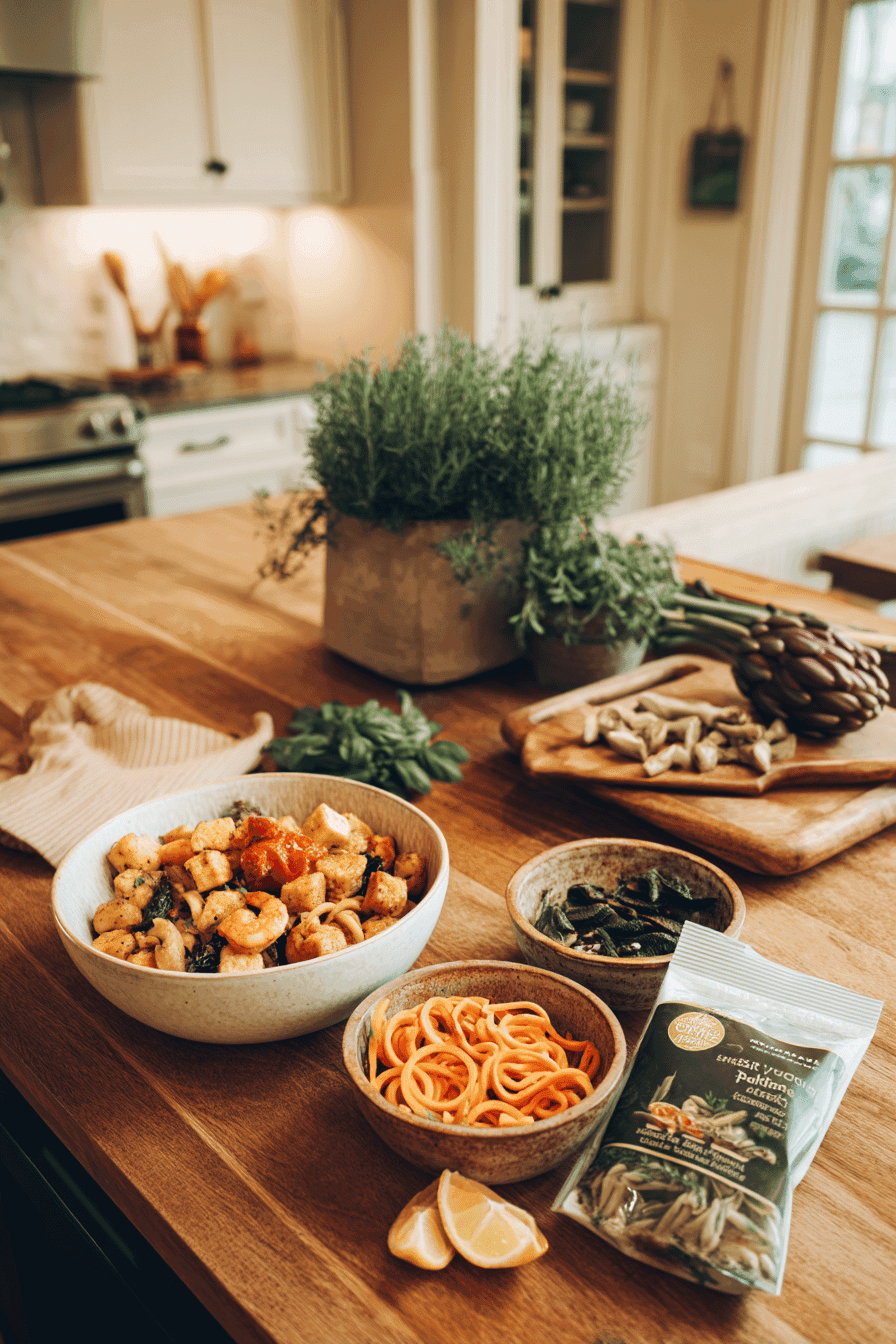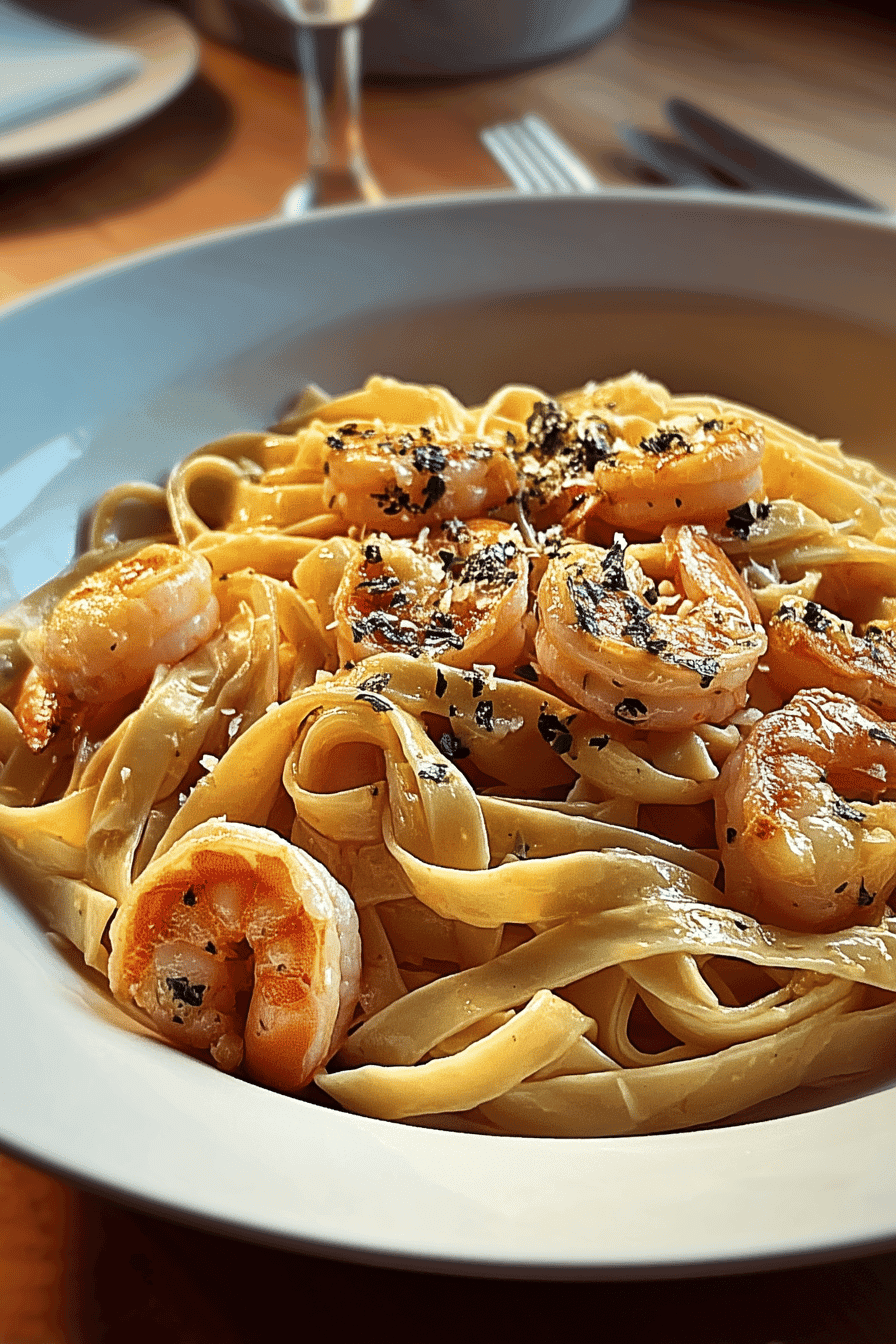Benefits and Advantages of Shrimp Pasta
Shrimp pasta offers a deliciously simple yet satisfying meal that appeals to a wide range of palates. Its easy preparation suits both hectic weeknights and relaxed weekend dinners, requiring minimal cooking time and ingredients. From a nutritional standpoint, shrimp provides a lean source of high-quality protein packed with essential nutrients like vitamin B12, iodine, and heart-healthy omega-3 fatty acids. Combined with carbohydrate-rich pasta, this dish supplies sustained energy and fullness.
The addition of fresh herbs, garlic, and olive oil boosts flavor while imparting antioxidants and healthy fats, making the dish well-rounded and wholesome. Shrimp pasta’s versatility allows for various ingredient swaps and customization to meet different dietary preferences such as gluten-free, vegan-adapted, or low-calorie options. Furthermore, using synonyms and related terms such as seafood pasta or prawn linguine enhances SEO while keeping the content engaging and comprehensive.
Enjoy a convenient yet nutritious shrimp pasta that rivals restaurant-quality flavors with ease at home.
Jump to:
- Benefits and Advantages of Shrimp Pasta
- Essential Ingredients for Shrimp Pasta
- Dietary Substitutions to Customize Your Shrimp Pasta
- How to Prepare the Perfect Shrimp Pasta: Step-by-Step Guide
- Mastering Shrimp Pasta: Advanced Tips and Variations
- How to Store Shrimp Pasta: Best Practices
- Nutritional Value of Shrimp Pasta
- FAQs: Frequently Asked Questions About Shrimp Pasta
- Garlic Butter Shrimp Pasta Recipe for a Creamy, Flavorful Dinner
- Ingredients
- Instructions
- Last Step:
- Notes
- Nutrition
- Did you make this recipe?
Essential Ingredients for Shrimp Pasta
To prepare a classic garlic butter shrimp pasta, gather the following ingredients:
- 12 ounces linguine or spaghetti (can substitute with gluten-free pasta)
- 1 pound peeled and deveined shrimp (preferably large, such as 21-30 count per pound)
- 3 tablespoons extra virgin olive oil
- 4 cloves garlic, finely minced
- 1 teaspoon red pepper flakes for mild heat
- 1 cup cherry tomatoes, halved
- Fresh parsley, chopped, for garnish
- Juice of 1 lemon for brightness
- Salt and black pepper to taste
For vegan or gluten-free considerations, use gluten-free pastas like rice or chickpea varieties, and substitute shrimp with marinated tofu or king oyster mushrooms to maintain texture and flavor. Zucchini noodles offer a low-calorie alternative that retains bulk and moisture. These carefully chosen ingredients balance the dish’s flavor, texture, and nutrition.

Dietary Substitutions to Customize Your Shrimp Pasta
Shrimp pasta can easily be tailored to meet diverse dietary preferences and ingredient availability:
- Vegetarian/Vegan: Replace shrimp with plant-based proteins such as tofu, tempeh, or artichoke hearts, which provide hearty texture and absorb flavors.
- Gluten-Free: Choose gluten-free pasta options made from rice, quinoa, or lentils to accommodate gluten sensitivity.
- Low-Calorie: Swap traditional pasta for spiralized vegetables like zucchini or carrots to reduce carbohydrate content significantly.
- Dairy-Free: Omit cheese or use plant-based cheese alternatives to maintain creaminess without dairy.
- Low-Sodium: Use low-sodium broth and moderate the added salt or replace with salt alternatives to suit dietary needs.
These substitutions keep the shrimp pasta accessible and flavorful for a broad range of eaters while maintaining the core essence of the dish.

How to Prepare the Perfect Shrimp Pasta: Step-by-Step Guide
- Cook Pasta: Bring a large pot of salted water to a boil. Add 12 ounces of linguine or spaghetti and cook until al dente according to package instructions. Reserve 1 to 2 cups of pasta water before draining the pasta and setting it aside.
- Sauté Garlic: In a large skillet over medium heat, add 1 tablespoon butter and 1 tablespoon olive oil. Sauté 4 cloves of minced garlic until fragrant, approximately 30-45 seconds, avoiding browning to prevent bitterness.
- Cook Shrimp: Add the peeled and deveined shrimp (seasoned with smoked paprika, salt, and pepper) in batches to avoid overcrowding. Cook for about 30-45 seconds per side until pink and opaque, then remove and set aside.
- Add Tomatoes and Sauce Components: In the same skillet, melt 2 tablespoons butter. Add halved cherry tomatoes and red pepper flakes; cook for 2 minutes until tomatoes soften slightly. Optionally, incorporate ½ cup dry white wine and reserved pasta water, simmering to reduce.
- Make Creamy Sauce: For a creamy texture without heavy cream, whisk milk and cornstarch before adding to skillet; simmer until thickened. Alternatively, add heavy cream directly and simmer briefly. Season with salt, pepper, and freshly shredded Parmesan cheese, stirring until melted and smooth.
- Combine Pasta and Shrimp: Toss drained pasta in the sauce, gradually adding reserved pasta water to reach desired consistency. Return shrimp to the skillet and gently mix to combine and warm through.
- Finish and Serve: Squeeze fresh lemon juice over the dish for brightness. Garnish with chopped fresh parsley and serve with additional Parmesan and freshly cracked black pepper as desired.
This straightforward method delivers a luscious, flavorful shrimp pasta that’s perfect for any night of the week. For vegan or gluten-free versions, follow the same process, substituting ingredients accordingly.
Mastering Shrimp Pasta: Advanced Tips and Variations
To enhance your shrimp pasta and achieve restaurant-quality results, consider incorporating several advanced techniques and variations. First, adding a splash of dry white wine like Pinot Grigio during the sauce-making step can introduce a pleasant acidity that brightens the dish. For a creamier sauce, stir in heavy cream or heavy whipping cream after sautéing the garlic; alternatively, use milk thickened with cornstarch for a lighter texture.
Experiment with flavor boosters such as sun-dried tomatoes or capers for a savory depth, or fresh herbs like basil and parsley to add freshness. Roasting the shrimp briefly before adding them into the sauce imparts a delightful texture contrast and intensifies their natural sweetness. Those who prefer spice can increase the amount of crushed red pepper flakes or add smoked paprika for warmth without overpowering the dish.
To diversify pasta choice, try swapping linguine or spaghetti with fettuccine or gluten-free pasta varieties to suit dietary preferences. Incorporating leafy greens such as baby spinach into the skillet not only boosts nutrition but also adds color and texture. These variations enable you to customize shrimp pasta while maintaining its delightful balance of rich, garlicky butter and tender shrimp.
How to Store Shrimp Pasta: Best Practices
Proper storage is essential to preserving the texture and flavor of shrimp pasta. Once cooked, transfer leftovers to an airtight container and refrigerate within two hours to prevent spoilage. Stored properly, the shrimp pasta will remain fresh for up to three days in the refrigerator.
For longer preservation, freezing is possible. Pack the pasta into freezer-safe containers or heavy-duty bags, removing as much air as possible to avoid freezer burn. Frozen shrimp pasta is best consumed within two months. Before reheating, thaw the dish overnight in the refrigerator.
Reheat gently in a skillet over low-medium heat, adding a splash of water or broth to loosen the sauce and avoid drying out the shrimp and pasta. Microwaving is not recommended as it can lead to uneven heating and rubbery shrimp. By following these storage and reheating guidelines, you ensure that your shrimp pasta retains its creamy texture and vibrant flavors.
Nutritional Value of Shrimp Pasta
| Nutrient | Amount per Serving |
|---|---|
| Calories | 370–400 kcal |
| Protein | 22 g |
| Carbohydrates | 41 g |
| Fat | 13 g (6 g saturated) |
| Cholesterol | 107 mg |
| Sodium | 659 mg |
| Fiber | 2 g |
| Sugar | 4 g |
Shrimp pasta is a nutritious meal rich in high-quality protein from shrimp, which supports muscle health and repair. The dish provides complex carbohydrates from pasta for sustained energy. Healthy fats mainly derive from olive oil and butter, while Parmesan cheese adds calcium and enhances flavor. Including garlic contributes antioxidants and may support immune function. Using fresh, wholesome ingredients ensures a balanced meal suitable for various dietary goals.

FAQs: Frequently Asked Questions About Shrimp Pasta
Print
Garlic Butter Shrimp Pasta Recipe for a Creamy, Flavorful Dinner
🦐 Dive into a dish rich with creamy garlic and succulent shrimp, ideal for a cozy dinner.
🍝 Easy to whip up, yet sophisticated enough to impress guests or treat yourself!
- Total Time: 40 minutes
- Yield: 6 to 7 servings 1x
Ingredients
1 to 2 pounds peeled, deveined shrimp (21–30 count preferred)
1 ½ teaspoons smoked paprika (or regular paprika)
Salt and pepper to taste
12 ounces linguine or spaghetti
1 tablespoon butter
1 tablespoon olive oil
2 tablespoons butter
3 to 4 cloves garlic, finely minced
1 ½ cups milk or heavy cream
2 teaspoons cornstarch (if using milk)
¼ teaspoon salt
Pinch of black pepper
1 cup freshly shredded Parmesan cheese
Chopped fresh parsley for garnish
½ cup dry white wine (optional)
Lemon zest or lemon juice (optional)
Crushed red pepper flakes (optional)
Baby spinach or sun-dried tomatoes (optional)
Instructions
1. Pat shrimp dry and season with smoked paprika, salt, and pepper.
2. Bring a pot of salted water to a boil; cook pasta according to package instructions. Reserve 1 to 2 cups pasta water, then drain.
3. In a skillet, heat butter and olive oil over medium heat. Cook shrimp in batches for 30-45 seconds per side until pink; remove and set aside.
4. Using the same skillet, melt butter and sauté garlic until fragrant, about 30-45 seconds.
5. For sauce, if using milk, whisk with cornstarch and add to skillet. If using cream, add directly. Include wine if using, and reduce slightly.
6. Season with salt, pepper, and Parmesan, stirring until cheese melts. Adjust consistency with reserved pasta water.
7. Toss pasta in skillet with sauce. Reintroduce shrimp, combining thoroughly.
8. Garnish with parsley, extra Parmesan, and lemon zest if desired. Serve immediately.
Last Step:
Please leave a rating and comment letting us know how you liked this recipe! This helps our business to thrive and continue providing free, high-quality recipes for you.Notes
🧄 Smoked paprika adds depth, but regular paprika works if needed.
⚖️ Cook shrimp in batches for even searing; avoid overcrowding.
💧 Use pasta water to adjust sauce texture, enhancing creaminess.
- Prep Time: 15 minutes
- Cook Time: 25 minutes
- Category: Main Course
- Method: Sautéing
- Cuisine: American-Italian
- Diet: Pescatarian
Nutrition
- Serving Size: 1 plate
- Calories: 371
- Sugar: 4 g
- Sodium: 659 mg
- Fat: 13 g
- Saturated Fat: 6 g
- Unsaturated Fat: N/A
- Trans Fat: 0 g
- Carbohydrates: 41 g
- Fiber: 2 g
- Protein: 22 g
- Cholesterol: 107 mg







